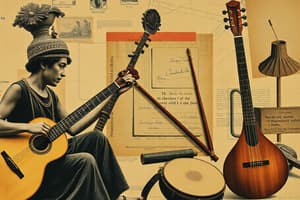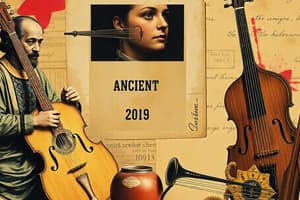Podcast
Questions and Answers
How does the discovery of a 40,000 BCE animal bone flute in Slovenia contribute to our understanding of early human societies?
How does the discovery of a 40,000 BCE animal bone flute in Slovenia contribute to our understanding of early human societies?
- It proves that early human societies were more advanced than previously thought in all technological aspects.
- It suggests that early humans had developed sophisticated musical instruments and a sense of artistic expression. (correct)
- It indicates trade routes existed between Slovenia and other regions during that time.
- It confirms that early humans primarily used music for hunting rituals.
The bull-headed lyre discovered in Queen Pu-abi's grave suggests what about the role of music in ancient Sumerian society?
The bull-headed lyre discovered in Queen Pu-abi's grave suggests what about the role of music in ancient Sumerian society?
- Musical instruments were symbols of status and power, reserved for royalty. (correct)
- Sumerian music was primarily focused on percussion instruments.
- Music was exclusively for religious ceremonies and not for entertainment.
- The bull was a sacred animal, and the lyre was used in sacrifices.
Considering the lute and harp were developed by the ancient Egyptians, how might their design have influenced later stringed instruments?
Considering the lute and harp were developed by the ancient Egyptians, how might their design have influenced later stringed instruments?
- Advancements in sound amplification techniques.
- Fundamental principles of string tension and sound production. (correct)
- The exclusive use of animal gut strings.
- The standardization of a four-string design.
What can be inferred from the fact that the oldest written music, found in Ugarit, Syria, includes words and instructions on tuning the lyre?
What can be inferred from the fact that the oldest written music, found in Ugarit, Syria, includes words and instructions on tuning the lyre?
If the Greek word 'mousike' relates to the 'art of the Muses,' how does this etymology reflect the cultural value placed on music in ancient Greece?
If the Greek word 'mousike' relates to the 'art of the Muses,' how does this etymology reflect the cultural value placed on music in ancient Greece?
In ancient Athenian schools, pupils were taught to play the aulos, kithara, and syrinx. How might learning these instruments have contributed to a student's broader education?
In ancient Athenian schools, pupils were taught to play the aulos, kithara, and syrinx. How might learning these instruments have contributed to a student's broader education?
Considering the animal bone flute found in Slovenia dates back to 40,000 BCE, what implications does this have for understanding the cognitive abilities of Neanderthals?
Considering the animal bone flute found in Slovenia dates back to 40,000 BCE, what implications does this have for understanding the cognitive abilities of Neanderthals?
If Queen Pu-abi's bull-headed lyre was elaborately decorated, how might this reflect the social stratification of ancient Sumerian society?
If Queen Pu-abi's bull-headed lyre was elaborately decorated, how might this reflect the social stratification of ancient Sumerian society?
Given that the ancient Egyptians developed the lute and harp, and the Greeks associated music with the Muses, how does this influence the understanding of music's role in ancient societies?
Given that the ancient Egyptians developed the lute and harp, and the Greeks associated music with the Muses, how does this influence the understanding of music's role in ancient societies?
If Athenian pupils learned the aulos, kithara, and syrinx, how might this contribute to a deeper understanding of the cultural values of ancient Greece?
If Athenian pupils learned the aulos, kithara, and syrinx, how might this contribute to a deeper understanding of the cultural values of ancient Greece?
Flashcards
What is a flute?
What is a flute?
A musical instrument found in Slovenia, made from animal bone, dating back to 40,000 BCE.
What was found in Queen Pu-abi's grave?
What was found in Queen Pu-abi's grave?
A bull-headed lyre.
Name two early Egyptian string instruments.
Name two early Egyptian string instruments.
Lute and harp.
Where was the oldest written music found?
Where was the oldest written music found?
Signup and view all the flashcards
Origin of the word 'music'?
Origin of the word 'music'?
Signup and view all the flashcards
Instruments taught in Athenian schools?
Instruments taught in Athenian schools?
Signup and view all the flashcards
Study Notes
- A musical artifact made from an animal bone was found in Slovenia and is believed to have been constructed in 40,000 BCE, and it's a Flute.
- A bull-headed lyre was discovered in the grave of Queen Pu-abi from Ur.
- Two examples of early string instruments by the ancient Egyptians include the lute and harp.
- The oldest written music was found in Ugarit, Syria, including words and instructions on tuning the lyre.
- The Greek word "mousike" means "art of the Muses. In their myths, the nine muses (spirits) gave the gifts of music, dancing, and singing to humans.
- Pupils at the Athenian school in Ancient Greece were taught to play the aulos (double-reed pipe), kithara (large lyre), and syrinx (panpipes).
Studying That Suits You
Use AI to generate personalized quizzes and flashcards to suit your learning preferences.



